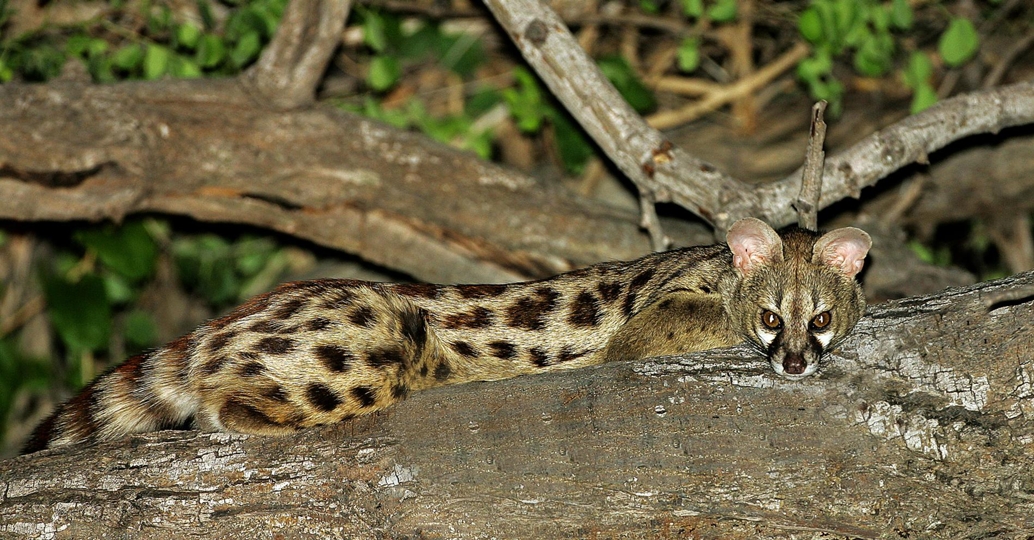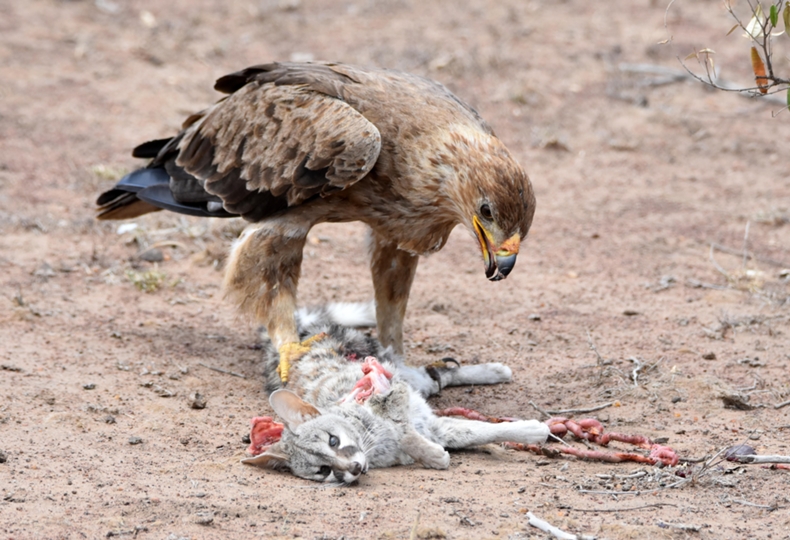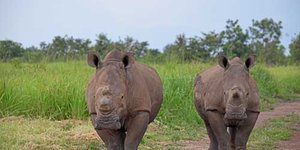Like this article?
Go on, give it a kudu!

Published on March 04 2019 | Updated on October 27 2021
Written by:
yourafricansafari.com
10554 views
Three of the most-likely species of genet to be seen on safari are: common, large-spotted and small-spotted genet.
Between 14 to 17 genet species are found throughout the largest parts of Africa.
Genets are nocturnal.
Genets have retractable claws.
A cat-like carnivore with a leopard pattern—the genet is a unique critter that will surely grab attention on your African safari. Even if it may hang around the safari lodge with its highly distinctive musky smell, it surely is not a cat! Its closest family members are the mongoose and civet and between 14 to17 genet species are found throughout the largest parts of Africa. It is also not uncommon to find members of the common genet family on the European continent.
Common throughout most of the African continent, thanks to its complex evolutionary history in Africa, today’s genet is well-adapted to several kinds of African habitats, from forestry environments to grassland. Three of the most likely to be seen genets include the large-spotted genet, the small-spotted genet and the common genet.

The large-spotted genet ranges across almost the entire Africa continent, from Ethiopia in the North to South Africa in the South, but it avoids the desert and semi-desert environments of the Sahara and Kalahari. The small-spotted genet is commonly found throughout Southern Africa, although it is also known to avoid the drier regions, such as Namibia. Genets are small carnivores weighing around two kilograms, depending on whether a large- or small-spotted genet species. Sizes can vary and it a more trustworthy distinguishing factor between the two genets is the coloring of their tail tips! Large-spotted genets have black-tipped tails whereas small-spotted genets have white-tipped tails.
Genets can forage endlessly on insects and fruits in grassland, and forest fringes making them animals with quite a peculiar diet. They are equally known for hunting smaller mammals, birds, eggs, rodents and even amphibians such as frogs, making them all round African wildlife. They are busy little wildlife creatures and spend hours climbing trees to hunt for birds or bird eggs, or scrambling around grassland rocks for smaller prey. Because they are incredibly agile and flexible, they can equally hunt and hide in obscure places—no hole is too small or tree too high for these brave ones.
Conservationists happily report that genet cat populations are large and growing and they have very few conservation threats. Genets have a wide diet and can survive on many kinds of prey and food. This is said to be one of the key reasons why they are doing well in the African survival race. Another reason is their anatomy—with their low center of gravity and agility, they can outrun and outsmart several predators which typically include caracals, leopards, honey badgers and even large owls.

Genets are known to encroach on human areas during winter times, although development and urbanization also contribute to this encroachment. This creates some urban-wildlife conflict much as is found in the farming communities surrounding natural environments. Despite the genets’ small size, it is also not uncommon for them to be mistaken for leopards in areas of poor bush visibility, especially because of their leopard-like markings. This results in some unnecessary fatalities and unintended hunting of genets.
Aside from the obvious reason—that they look very feline in nature—we can thank the ancient Greeks for this misnomer. It is said that in ancient times, genets were presented as catching rats and rodents in domestic environments. This became traditional thought, and ancient Greek tapestries tell stories of genet cats as domestic rat catchers. But, with the help of biology experts, we now know that genets are indeed not cats.
On your African safari, you are more likely to spot them during a night drive or sunset safari, as they are mostly nocturnal hunters. During the day, they are less active and prefer resting under vegetation cover or, if the environment allows, in trees, caves or burrows. It is entirely possible to spot genets during the day, but it is difficult with an untrained eye, as they blend seamlessly into their environment.
With their slinky shape and leopard-like fur markings, genets have unfortunately captured our imagination, and the household pet market. But genets remain wildlife and are not recommended as exotic pets. Even meeting their most basic diets can be problematic as genets have evolved to survive on rather broad and complicated diets. As nocturnal animals, genets will suffer if placed in a household as pet. Genets will hardly make cuddly pets. Genet cats are solitary animals and only live in groups when they raise their young and even then, they only live in groups for a few months. Likewise, males and females live separately and are not fond of social behavior as one would expect from a domestic pet. Each on their own, genet cats have extremely large territories where they live and hunt on their own and communicate their territories to others through scent marking and scent communication.
Genets are remarkable small carnivores with highly intellectual behavior patterns which make them most enjoyable to trace and watch on your next African safari.
For more information on genets, please visit our animal page.
Has been on: 15 safaris
Your African Safari (YAS) is a safari-planning resource for anyone planning an African safari. It features information on over 2600 tour operators including company and vehicle descriptions, user reviews, safari itineraries and photos. It also features detailed information on 14 countries and 84 parks and game reserves.
© Your African Safari Ltd, All rights reserved.
Your African Safari is a safari-planning and safari review site. It was created to help support a healthy African wildlife population. All reviews are vetted before being approved and only ethical tours are published

Garamba National Park—an anchor of hope in the Democratic Republic of Congo
Published on January 09 2025
By: R.W.

Namibia imposes new visa requirements
Published on July 25 2024
By: yourafricansafari.com

Do I really need travel insurance or travel protection for my safari?
Published on July 30 2024
By: yourafricansafari.com